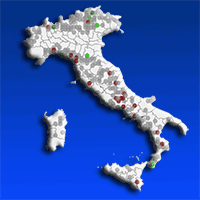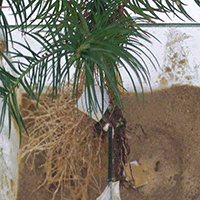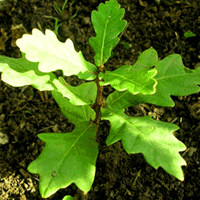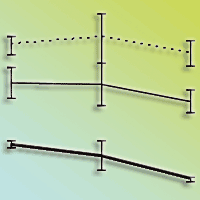
Preliminary indications for diverging heat and drought sensitivities in Norway spruce and Scots pine in Central Europe
iForest - Biogeosciences and Forestry, Volume 13, Issue 2, Pages 89-91 (2020)
doi: https://doi.org/10.3832/ifor3216-012
Published: Mar 01, 2020 - Copyright © 2020 SISEF
Short Communications
Abstract
Massive and increasing tree mortality is currently observed in the two conifer species Norway spruce and Scots pine in Central Europe. Consecutive dry years are made responsible for this phenomenon. Leaf trait measurements, in specific leaf osmotic potential (πosm) and leaf water potential at turgor loss (πtlp), indicate that the underlying mechanisms for tree mortality are most likely different between the two species. πtlp of spruce was highly negative, revealing a potentially high drought tolerance of the species. πtlp of Scots pine was less negative, suggesting a higher susceptibility to drought stress. I conclude that the mortality of Norway spruce might be caused by rising temperatures and that the summer temperatures in the past years were beyond the species thermal tolerance threshold. Overall, I want to highlight and enhance the discussion that the search for suitable species for a climate change adapted forest should go in both directions, i.e., species should be chosen to make the forest fit for both increasing drought and heat stress.
Keywords
Tree Mortality, Water Stress, Heat Stress, Physiological Limitations, Conifers
Authors’ Info
Authors’ address
Conservation Ecology Center, Smithsonian Conservation Biology Institute, Front Royal, VA (USA)
Center for Tropical Forest Science - Forest Global Earth Observatory, Smithsonian Tropical Research Institute, Panama (Republic of Panama)
Corresponding author
Paper Info
Citation
Kunert N (2020). Preliminary indications for diverging heat and drought sensitivities in Norway spruce and Scots pine in Central Europe. iForest 13: 89-91. - doi: 10.3832/ifor3216-012
Academic Editor
Tamir Klein
Paper history
Received: Aug 18, 2019
Accepted: Dec 11, 2019
First online: Mar 01, 2020
Publication Date: Apr 30, 2020
Publication Time: 2.70 months
Copyright Information
© SISEF - The Italian Society of Silviculture and Forest Ecology 2020
Open Access
This article is distributed under the terms of the Creative Commons Attribution-Non Commercial 4.0 International (https://creativecommons.org/licenses/by-nc/4.0/), which permits unrestricted use, distribution, and reproduction in any medium, provided you give appropriate credit to the original author(s) and the source, provide a link to the Creative Commons license, and indicate if changes were made.
Web Metrics
Breakdown by View Type
Article Usage
Total Article Views: 42738
(from publication date up to now)
Breakdown by View Type
HTML Page Views: 36303
Abstract Page Views: 3267
PDF Downloads: 2443
Citation/Reference Downloads: 16
XML Downloads: 709
Web Metrics
Days since publication: 2114
Overall contacts: 42738
Avg. contacts per week: 141.52
Citation Metrics
Article Citations
Article citations are based on data periodically collected from the Clarivate Web of Science web site
(last update: Mar 2025)
Total number of cites (since 2020): 26
Average cites per year: 4.33
Publication Metrics
by Dimensions ©
Articles citing this article
List of the papers citing this article based on CrossRef Cited-by.
References
A global overview of drought and heat-induced tree mortality reveals emerging climate change risks for forests. Forest Ecology and Management 259: 660-684.
CrossRef | Gscholar
Ecosystem dynamics and management after forest die-off: a global synthesis with conceptual state-and-transition models. Ecosphere 8 (12): e02034.
CrossRef | Gscholar
Variation in fine root biomass of three European tree species: Beech (Fagus sylvatica L.), Norway spruce (Picea abies L. Karst.), and Scots pine (Pinus sylvestris L.). Plant Biosystems 141: 394-405.
CrossRef | Gscholar
Anweisung zur Holzzucht für Förster [Instructions for tree breeding for foresters]. Neue akademische Buchhandlung, Marburg, Germany, pp. 143. [in German]
Gscholar
Absterbeerscheinungen der Kiefer in Mittelfranken [Pine die-off in Central Frankonia]. AFZ-Der Wald 11: 20-22. [in German]
Gscholar
Das Ende der Kiefer als Hauptbaumart in Mittelfranken [The end of pine as main tree species in Central Frankonia]. AFZ - Der Wald 3: 24-25. [in German]
Gscholar
600 Jahre Nadelwaldsaat, die Leistung des Peter Stromer von Nürnberg [600 years of conifer cropping system, the achievments of Peter Stromer from Nuremberg]. In “Reichswälder bei Nürnberg - aus der Geschichte des ältesten Kunstforstes” [The imperial forests around Nuremberg - history of the oldest manmade forest] (Sperber G ed). Mitteilungen aus der Staatsforstverwaltung Bayerns, München and Neustadt an der Aisch, Germany, pp. 25. [in German]
Gscholar

















